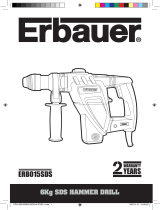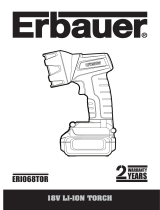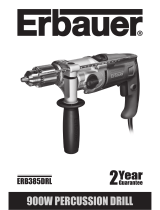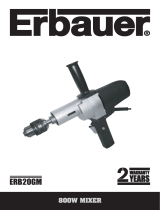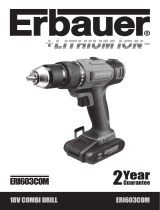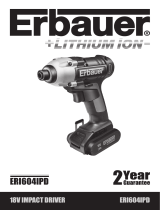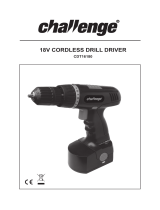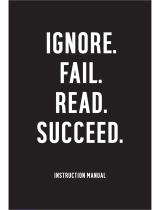Page is loading ...

14.4V LI-ION DRILL DRIVER
WARRANTY
YEARS
ERH008DDH
ERH005DDH
CDT114L ERH008DDH ERH005DDH-M-070611.indd 1 2007-6-14 10:43:28

GUARANTEE
This product carries a Screwfix Direct Ltd guarantee of 24 months. If your
product develops a fault within this period, you should, in the first instance contact
Screwfix Direct Ltd on Freephone 0500 41 41 41. If the fault occurs within the first 24
months, you may return the goods for a full refund or we will repair or replace the goods
if you prefer. When repair is not practical or identical goods are not available, alternative
goods of similar specification and quality will usually be provided but, failing this, you
will be offered a partial or full refund depending on the time period since purchase.
This guarantee specifically excludes losses caused due to:
- Fair wear and tear
- Misuse or abuse
- Lack of routine maintenance
- Failure of consumable items (such as batteries)
- Accidental damage
- Cosmetic damage
- Failure to follow manufacturer’s guidelines
- Loss of use of the goods
- Repairs attempted by anyone, unless authorised by Screwfix Direct Ltd.
This guarantee does not affect your statutory rights. This guarantee is only valid in the UK.
For further technical advice and spare parts please contact the customer helpline
number on 0845 607 6380.
Congratulations on your purchase of a quality power tool from Screwfix
Direct Ltd. This product should give you reliable service but for your peace
of mind this power tool does carry a 24-month guarantee, the terms
of which are detailed below.
If this product develops a fault within the guarantee period contact Screwfix
Direct Ltd on Freephone 0500 41 41 41.
Please retain this handbook in case you need to refer to safety, care or
guarantee information in the future.
CDT114L ERH008DDH ERH005DDH-M-070611.indd 2 2007-6-14 10:43:29

14.4V LI-ION DRILL DRIVER
SAFETY INSTRUCTIONS
Warning! Read all safety warnings and all instructions. Failure to follow
the warnings and instructions may result in electric shock, fire and/or serious
injury.
Save all warnings and instructions for future reference.
The term “power tool” in the warnings refers to your mains-operated (corded) power
tool or battery-operated (cordless) power tool.
1. Work area safety
a. Keep work area clean and well lit. Cluttered or dark areas invite accidents.
b. Do not operate power tools in explosive atmospheres, such as in the
presence of flammable liquids, gases or dust. Power tools create sparks
which may ignite the dust or fumes.
c. Keep children and bystanders away while operating a power tool.
Distractions can cause you to lose control.
2. Electrical safety
a. Power tool plugs must match the outlet. Never modify the plug in any
way. Do not use any adapter plugs with earthed (grounded) power tools.
Unmodified plugs and matching outlets will reduce risk of electric shock.
b. Avoid body contact with earthed or grounded surfaces, such as pipes,
radiators, ranges and refrigerators. There is an increased risk of electric shock
if your body is earthed or grounded.
c. Do not expose power tools to rain or wet conditions. Water entering a
power tool will increase the risk of electric shock.
d. Do not abuse the cord. Never use the cord for carrying, pulling or
unplugging the power tool. Keep cord away from heat, oil, sharp edges or
moving parts. Damaged or entangled cords increase the risk of electric shock.
e. When operating a power tool outdoors, use an extension cord suitable
for outdoor use. Use of a cord suitable for outdoor use reduces the risk of electric
shock.
f. If operating a power tool in a damp location is unavoidable, use a
residual current device (RCD) protected supply. Use of an RCD reduces the
risk of electric shock.
3. Personal safety
a. Stay alert, watch what you are doing and use common sense when
operating a power tool. Do not use a power tool while you are tired or
under the influence of drugs, alcohol or medication. A moment of inattention
while operating power tools may result in serious personal injury.
b. Use personal protective equipment. Always wear eye protection.
Protective equipment such as dust mask, non-skid safety shoes, hard hat, or
hearing protection used for appropriate conditions will reduce personal injuries.
c. Prevent unintentional starting. Ensure the switch is in the off-position
before connecting to power source and/or battery pack, picking up
or carrying the tool. Carrying power tools with your finger on the switch or
energising power tools that have the switch on invites accidents.
CDT114L ERH008DDH ERH005DDH-M-070611.indd 3 2007-6-14 10:43:29

d. Remove any adjusting key or wrench before turning the power tool on.
A wrench or a key left attached to a rotating part of the power tool may result in
personal injury.
e. Do not overreach. Keep proper footing and balance at all times. This
enables better control of the power tool in unexpected situations.
f. Dress properly. Do not wear loose clothing or jewellery. Keep your hair,
clothing and gloves away from moving parts. Loose clothes, jewellery or
long hair can be caught in moving parts.
g. If devices are provided for the connection of dust extraction and
collection facilities, ensure these are connected and properly used. Use
of dust collection can reduce dust-related hazards.
4. Power tool use and care
a. Do not force the power tool. Use the correct power tool for your
application. The correct power tool will do the job better and safer at the rate for
which it was designed.
b. Do not use the power tool if the switch does not turn it on and off. Any
power tool that cannot be controlled with the switch is dangerous and must be
repaired.
c. Disconnect the plug from the power source and/or the battery pack from
the power tool before making any adjustments, changing accessories, or
storing power tools. Such preventive safety measures reduce the risk of starting
the power tool accidentally.
d. Store idle power tools out of the reach of children and do not allow
persons unfamiliar with the power tool or these instructions to operate
the power tool. Power tools are dangerous in the hands of untrained users.
e. Maintain power tools. Check for misalignment or binding of moving
parts, breakage of parts and any other condition that may affect the
power tool’s operation. If damaged, have the power tool repaired before
use. Many accidents are caused by poorly maintained power tools.
f. Keep cutting tools sharp and clean. Properly maintained cutting tools with
sharp cutting edges are less likely to bind and are easier to control.
g. Use the power tool, accessories and tool bits etc. in accordance with
these instructions, taking into account the working conditions and the
work to be performed. Use of the power tool for operations different from those
intended could result in a hazardous situation.
5. Battery tool use and care
a. Recharge only with the charger specified by the manufacturer. A charger
that is suitable for one type of battery pack may create a risk of fire when used with
another battery pack.
b. Use power tools only with specifically designated battery packs. Use
of any other battery packs may create a risk of injury and fire.
c. When battery pack is not in use, keep it away from other metal objects,
like paper clips, coins, keys, nails, screws or other small metal objects,
that can make a connection from one terminal to another. Shorting the
battery terminals together may cause burns or a fire.
d. Under abusive conditions, liquid may be ejected from the battery;
avoid contact. If contact accidentally occurs, flush with water. If liquid
contacts eyes, additionally seek medical help. Liquid ejected from the battery
CDT114L ERH008DDH ERH005DDH-M-070611.indd 4 2007-6-14 10:43:29

14.4V LI-ION DRILL DRIVER
may cause irritation or burns.
6. Service
a. Have your power tool serviced by a qualified repair person using only
identical replacement parts. This will ensure that the safety of the power tool is
maintained.
HEALTH ADVICE
Warning! When drilling, sanding, sawing or grinding, dust particles will be
produced. In some instances, depending on the materials you are working with,
this dust can be particularly harmful to you (e.g. lead from old gloss paint).
You are advised to consider the risks associated with the materials you are working
with and to reduce the risk of exposure. You should:
- Work in a well-ventilated area.
- Work with approved safety equipment, such as those dust masks that are specially
designed to filter microscopic particles.
ADDITIONAL SAFETY INSTRUCTIONS
for drill
1. Always check walls, floors and ceilings for hidden power cables and pipes.
2. After long working periods, external metal parts and accessories could be hot.
3. Remove the battery pack from the drill before carrying out adjustments.
for charger
1. Only use the battery charger specifically stated on the base of the battery.
2. Charger is double insulated for additional electrical safety.
3. Charger is for indoor use only.
4. If the charger supply cord is damaged, it must be replaced by the manufacturer, its
service agent or similarly qualified persons in order to avoid a hazard.
for battery
1. Always remove the battery pack from the charger immediately after re-charging is
completed.
2. When not in use, remove a charged battery pack from the charger.
3. Do not charge a damaged battery pack.
4. Do not charge non-rechargeable batteries.
5. Lithium-ion and lithium polymer cells and battery packs may get hot, explode or
ignite and cause serious injury if exposed to abuse conditions.
6. Do not install the battery backwards so the polarity is reversed.
7. Do not connect the positive terminal and negative terminal of the battery to each
other with any metal object (such as wire).
8. Do not carry or store battery together with necklaces, hairpins or other metal
objects.
9. Do not pierce the battery with nails, strike the battery with a hammer, step on the
battery or otherwise subject it to strong impacts or shocks.
10. Do not solder directly onto the battery.
11. Do not expose battery to water or salt water, or allow the battery to get wet.
CDT114L ERH008DDH ERH005DDH-M-070611.indd 5 2007-6-14 10:43:30

SYMBOLS
Read the manual Warning Wear gloves
Wear dust mask,eye & ear protection
Conforms to relevant safety standards
12. Do not disassemble or modify the battery. The battery contains safety and protection
devices, which, if damaged, may cause the battery to generate heat, explode or ignite.
The protection circuit module provided with battery packs is not to be used as a
substitute for a shut-off switch.
13. Do not place the battery in or near fire, on stoves or other high temperature locations.
Do not place the battery in direct sunlight, or use or store the battery inside cars in hot
weather. Heating the battery can damage the safety circuitry, which can cause additional
heating, rupture or ignition of the battery. Using the battery in this manner may also
result in a loss of performance and a shortened life expectancy.
14. Do not place the battery in microwave ovens, high-pressure containers or on
induction cookware.
15. If you intend to store a battery for a period without use then store battery at room
temperature (19°C to 25°C), charged to about 30 – 50% of capacity. When storing for
very long periods boost-charge the battery once per year to prevent over discharge.
16. Always charge the battery in a temperature range of 0° to 40°C and discharge in a
temperature range of 0° to 60°C.
17. The battery pack and charger will be warm during charging, this is normal.
18. Do not continue charging the battery if it does not recharge within the specified
charging time. Doing so may cause the battery to become hot, explode or ignite. The
temperature range over which the battery can be charged is 0°C to 40°C. Charging the
battery at temperatures outside this range may cause severe damage to
the battery or
reduce battery life expectancy.
19. When the battery is worn out, insulate the terminals with adhesive tape or similar
materials before disposal.
20. Do not dispose of batteries in fire, or with household waste. Return exhausted
batteries to your local collection or recycling point.
21. Immediately discontinue use of the battery if, while using, charging or storing the
battery, the battery emits an unusual smell, feels hot, changes color or shape, or appears
abnormal in any other way.
22. In the event the battery leaks and the fluid gets into one’s eye, do not rub the eye.
Rinse well with water and immediately seek medical care. If left untreated, the battery
fluid could cause damage to the eye.
CDT114L ERH008DDH ERH005DDH-M-070611.indd 6 2007-6-14 10:43:30

14.4V LI-ION DRILL DRIVER
1. ON/OFF SWITCH
2. FORWARD AND REVERSE ROTATION SELECTOR
3. DOUBLE ENDED BIT
4. VARIABLE CLUTCH
5. KEYLESS CHUCK
6. BATTERY PACK LATCH
7. BATTERY PACK
8. SOFT GRIP HANDLE
1
2
3
8
7
4
5
6
CDT114L ERH008DDH ERH005DDH-M-070611.indd 7 2007-6-14 10:43:30

TECHNICAL DATA
Power: 14.4V
No load speed: 0-550min
-1
Max torque: 15Nm
Chuck capacity: 10mm
Drilling capacity in wood: 18mm
Drilling capacity in steel: 8mm
Battery capacity: 1.5Ah Lithium-Ion
Charging time: 3~5 hours
Net weight: 1.5kg
ACCESSORIES
1.5Ah Li-ion battery pack 1pc(ERH005DDH)
1.5Ah Li-ion battery pack 2pcs(ERH008DDH)
3-5H Charger 1pc
Double ended bit 1pc
VIBRATION DATA
Vibration level: 1.5m/s
2
CDT114L ERH008DDH ERH005DDH-M-070611.indd 8 2007-6-14 10:43:30

14.4V LI-ION DRILL DRIVER
CHARGING PROCEDURE
Note: Before using the tool read the
instruction manual carefully.
1. Before using your cordless drill
Your battery pack is UNCHARGED and you must
charge once before use.
Warning: The charger and battery pack are
specifically designed to work together so
do not attempt to use any other devices. Never
insert or allow metallic objects into your charger
or battery pack connections because an electrical
failure and hazard will occur.
2. To charge the battery pack (See Fig 1, 2)
Connect the charger to the battery socket (C) then
connect the power supply. The charging indicator
red light (A) will illuminate to show charging has
started.
A fully discharged battery will take approximately
3-5 hours to reach full charge. When charging is
complete, the red light (A) will be off. Unplug the
charger and remove the battery pack.
Important: Do not leave the battery on charge
continuously.
3. Temperature light indication (See Fig 1)
1) During charging
With the red charging indicator light (A) turning
on, the red temperature indicator light (B) will
only illuminate when the battery temperature is
over 40
o
C. It indicates that charging stops. The
charging process will automatically continue
until the battery pack has reached the suitable
temperature. The temperature light (B) will be off
at the same time.
2) During operation
The temperature light (B) will illuminate when the
battery temperature is over 60
o
C. It indicates that
the drill cannot work under such condition. The
drill stops working automatically. Allow the drill
to cool down for re-operation.
Fig 2
Fig 1
6
A
B
C
7
CDT114L ERH008DDH ERH005DDH-M-070611.indd 9 2007-6-14 10:43:31

Fig 5
4. To remove or install the battery pack to
drill (See Fig 3, 4)
Depress the battery pack latch to release and
slide it out from the drill. After recharge, slide the
battery pack back into the drill. A simple push and
slight pressure will be sufficient.
OPERATING INSTRUCTIONS
1. On/off switch with brake function
Depress to start and release to stop your drill. The
on/off switch is fitted with a brake function which
stops your chuck immediately when you quickly
release the switch.
2. Variable speed
This tool has a variable speed switch that delivers
higher speed and higher torque with increased
trigger pressure. Speed is controlled by the
amount of switch trigger depression.
Warning: Do not operate for long periods
at low speed excess heat will be produced
internally.
3. Switch lock (See Fig 5)
The On/Off switch trigger can be locked in OFF
position. This helps to reduce the possibility of
accidental starting when not in use. To lock the
switch, place the forward and reverse rotation
selector in the center position by pushing it on
either side of the drill.
4. Reversible (See Fig 6)
The forward and reverse rotation selector located
above the On/Off switch controls the direction
of rotation. For drilling and screw driving use
forward rotation marked “
” (lever is moved to
the left). Only use reverse rotation marked “
”
(lever is moved to the right) to remove screws or
release a jammed drill bit. When the selector is in
the center position, the switch is locked.
Warning: Never change the direction of
rotation when the chuck is rotating. Wait
until it has stopped.
Fig 3
Fig 4
Fig 6
CDT114L ERH008DDH ERH005DDH-M-070611.indd 10 2007-6-14 10:43:31

14.4V LI-ION DRILL DRIVER
5. Keyless chuck-fitting / removing drills
(See Fig 7)
To insert a drill or other accessory, the procedure
is as follows.
1) Lock the switch in OFF position
2) Grasp the rear sleeve of the chuck with one
hand and with the other hand turn the front chuck
anti-clockwise to open.
3) Insert the drill or other accessory into the
bottom of the chuck. Tighten by rotating the front
chuck clockwise with one hand while holding the
rear sleeve of the chuck.
To remove a drill or other accessory, repeat step
2.
6. Torque adjustment (See Fig 8)
Carry out a practical test to determine which of
the 15 settings of the variable clutch to the screws
are driven flush into the material.
1: Low setting, e. g., small screws, soft materials.
15: High setting, e. g., large screws, hard
materials.
With the correct setting, the clutch disengages as
soon as the screw is driven flush into the material
or the set torque is reached. Select a higher setting
when driving out screws, or set to the “Drilling”
symbol.
Drilling
Set the variable clutch to the “Drilling” symbol.
7. Drilling
Set the variable clutch to the “Drilling” symbol.
When drilling hard smooth surfaces, use a center
punch to mark the desired hole location. This will
prevent the drill bit from slipping off center as the
hole is started. Hold the tool firmly and place the
tip of the bit at the point to be drilled. Depress
the On/Off switch to start the tool. Move the drill
bit into the work-piece, applying only enough
pressure to keep the bit drilling. Do not force or
apply side pressure to elongate a hole.
Warning: When drilling in metal, only use
HSS drill bits in good condition. When
screw-driving, apply a small quantity of liquid
soap or similar material to the screw threads to
ease insertion.
8. Bit storage (See Fig 9)
The bit provided with the drill can be placed in the
storage area located on top of the drill.
Fig 8
Fig 9
Fig 7
CDT114L ERH008DDH ERH005DDH-M-070611.indd 11 2007-6-14 10:43:31

9. Disposal of an exhausted battery pack
To preserve natural resources, please recycle or
dispose of the battery pack properly. This battery
pack contains Lithium batteries. Consult your
local waste authority for information regarding
available recycling and/or disposal options.
Discharge your battery pack by operating your
drill, then remove the battery pack from the drill
housing and cover the battery pack connections
with heavy duty adhesive tape to prevent short
circuit and energy discharge. Do not attempt to
open or remove any of the components.
HANDY HINTS
General
1. Your cordless drill is useful for drilling holes as
well as driving and removing screws.
2. To prolong the life of your drill never overload
it; if it slows down while drilling, remove and try
again using less force on the drill. If the drill is
straining because the battery pack charge is low,
stop and recharge the battery pack.
3. Always use only a soft, dry cloth to clean
your drill; never use any detergent or alcohol.
Disconnect the charger from the mains supply
before cleaning.
Hole drilling
1. When attempting to drill a large diameter hole,
it is sometimes best to start with a smaller drill bit
then work up to the required size. This prevents
overloading the drill.
2. If the drill bit snags, switch off the drill
immediately to prevent permanent damage. Try
the reverse drive to remove the bit.
3. Keep the drill in line with the hole. Ideally, if the
angle is changed during drilling it could cause the
bit to break.
4. Frequently remove the drill bit from the hole
when drilling deep holes to allow the dust to be
ejected from the hole.
Screw driving
1. When driving in larger and/or longer screws in
hard material, it is advisable to drill a pilot hole
first, slightly longer and just smaller than the
shank diameter of the screw to be fitted. The pilot
CDT114L ERH008DDH ERH005DDH-M-070611.indd 12 2007-6-14 10:43:31

14.4V LI-ION DRILL DRIVER
hole will act as a guide for the screw and will
also make tightening of the screw less difficult.
When screws are positioned close to an edge of
the material, a pilot hole will also help to prevent
splitting of the wood.
2. Use only screwdriver bits that fit properly in
the head of the screw.
3. When driving screws, always keep enough
pressure on the drill to prevent wearing of the
screw head. It will be difficult to drive or remove
a screw if the screw head is worn.
TROUBLESHOOTING AND FAQ
Should you encounter any problems when using
your cordless drill, check the following list.
1. On/Off switch will not depress
The switch will not depress if the forward and
reverse rotation selector is in the locked position.
Move to the forward or reverse position and try
again.
2. On/Off switch depresses but drill will not
work
The cordless drill needs sufficient charge in the
battery pack to work. The battery charge will
deplete if not used for a long period of time. Try
recharging the battery pack.
3. Battery pack leaks
A small amount of leakage may occur under
extreme temperatures or after heavy use.
Immediately wash any leakage from hands, skin
or clothes with soap and water.
4. The drill body gets hot following extensive
use
Under normal load condition the body, trigger
and battery pack will heat up as the energy
absorbed in the drilling operation produces heat.
This is quite normal. Simply allow the drill to cool
off for a few minutes.
5. The battery pack gets warm during use
The power-draw from the battery generates heat.
This is increased as the energy draw increases.
You will not damage the battery pack and the
CDT114L ERH008DDH ERH005DDH-M-070611.indd 13 2007-6-14 10:43:31

generated heated heat is normal. Should you
desire to cool it down, simply allow the drill to
cool off prior to continuing work.
6. The battery pack gets warm when
charging
This is normal; it is a result from the stepping
down of the chemical reactions inside the
batteries during the charging process.
7. The charger will get warm during
charging
This is normal; it is a result of the stepping down
of the main supply from 240Vac to 14.4Vdc.
8. HOT battery pack protection
The normal charging temperature is between
0
o
C and 40
o
C. When the battery pack is too hot
during charging, it automatically starts a HOT
battery pack delay (the red temperature indicator
light (B) will illuminate), and suspends charging
until it has reached the correct temperature. The
charging process will then automatically begin
(the red temperature indicator light (B) will turn
off).
When the battery pack is over 60
o
C during
operation, the temperature light (B) will illuminate
to indicate that the drill cannot work under such
condition. The drill stops working automatically.
Allow the drill to cool down for re-operation.
9. Battery pack overload and low-voltage
protection
When max. allowable battery voltage is exceeded
during charging, the overload protection
is activated to protect the battery against
overheating.
When the battery is under normal voltage during
working, it will cease to operate.
ENVIRONMENTAL PROTECTION
Waste electrical products should not be
disposed of with household waste. Please
recycle where facilities exist. Check with
your Local Authority or retailer for recycling
advice.
CDT114L ERH008DDH ERH005DDH-M-070611.indd 14 2007-6-14 10:43:32

14.4V LI-ION DRILL DRIVER
Declaration of Conformity
We, Importer
Erbauer (UK) LTD BA22 8RT
Declare that the product
14.4
V LI-ION DRILL DRIVER
ERH005DDH ERH008DDH
Complies with the essential health and safety requirements of the following directives:
EC Machinery Directive -98/37/EC
EC Low Voltage Directive -2006/95/EC
EC Electromagnetic Compatibility Directive -89/336/EEC amended by 93/68/EEC
2002/95/EC Restrictions of the Use of Certain Hazardous Substances in Electrical and Electronic Equipment
Standards and technical specifications referred to:
EN 60745-1
EN 60745-2-1
EN 60745-2-2
EN 61000-3-2
EN 61000-3-3
EN 55014-1
EN 55014-2
EN 50366
EN 60335-1
EN 60335-2-29
2007
Authorised Signatory
Date: 01/01/07
Signature:
Name: Peter Harries
Erbauer (UK) Ltd
Quality Manager
CDT114L ERH008DDH ERH005DDH-M-070611.indd 15 2007-6-14 10:43:32

CDT114L ERH008DDH ERH005DDH-M-070611.indd 16 2007-6-14 10:43:32
/
